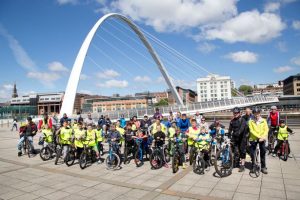To improve our understanding of what users of our product will want, we have arranged an interview on Wednesday 26th with Tim Parsons. We know little information about Tim apart from that he is a cyclist in the Newcastle area. Interviewing him will provide us with first hand data about cycling habits around Newcastle and what tools and devices will appeal to that community.
Please find below a brief interview schedule:
Introducing ourselves:
Thank you for arranging to meet up with us. We are second year students at Newcastle University and we are currently collaborating with Robert Snowball who is a senior transport planner at Newcastle City Council. Our aim is to make cycle routes around the city more accessible and well known, as well as attempting to increase the popularity of cycling with help from the council.
- What is your preferred method of travelling around the city on a day by day basis?
– Why is this your preferred method?
– Why do you not choose to travel by other means (e.g. car, walk, bus, cycle)
- Is the transport infrastructure in the city adequate for this method of travel?
– Do you think that other methods of travel are better provided for within the city?
– How do you think the council could improve existing travel infrastructure?
- How would you describe your position as a cyclist in Newcastle?
– Do you feel like your needs (either as a single cyclist or as part of a community) are met by the council?
- Can you describe the ways in which technology helps your everyday life?
– Is technology involved in your commute or travel?
– Do you use mobile technology to aid you this way?
- Do you frequently use any mobile apps? If so, why those specifically?
– Would you/have you used apps to improve your cycling mobility in particular?
- There are already apps that cyclists can use, could you detail any that you use, if at all?
– Why do you prefer these apps to other apps that you have mentioned? (e.g. are they simpler to understand? More accessible?)
- When looking at the design and functionality of a map, what would you say is most important to focus on?
– How do you use maps when cycling? (e.g. Planning ahead? Whilst on route?)
– What would you suggest to simplify reading maps and using apps for cyclists?
- In your opinion, what would encourage more engagement with cycling?
– Should there be more incentives for the cycling demographic?
– How about incentives from apps, the council and community groups?
- Should there be more improvements to current apps offered to cyclists? If so, could you suggest any?
– What stops people from using apps? Why is this?
- From the cyclists you know, would apps be their preferred choice of route planning and engagement?
– Why is this the case? Is this because the app itself is difficult to use? Are there issues with the way a cyclist can use a phone whilst out?
